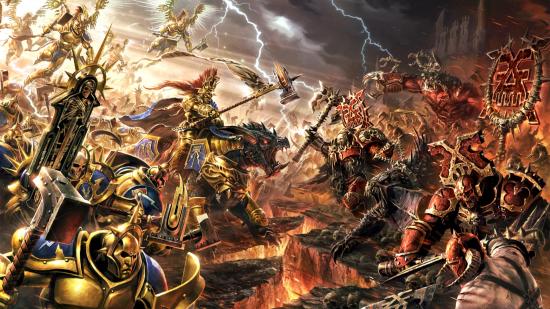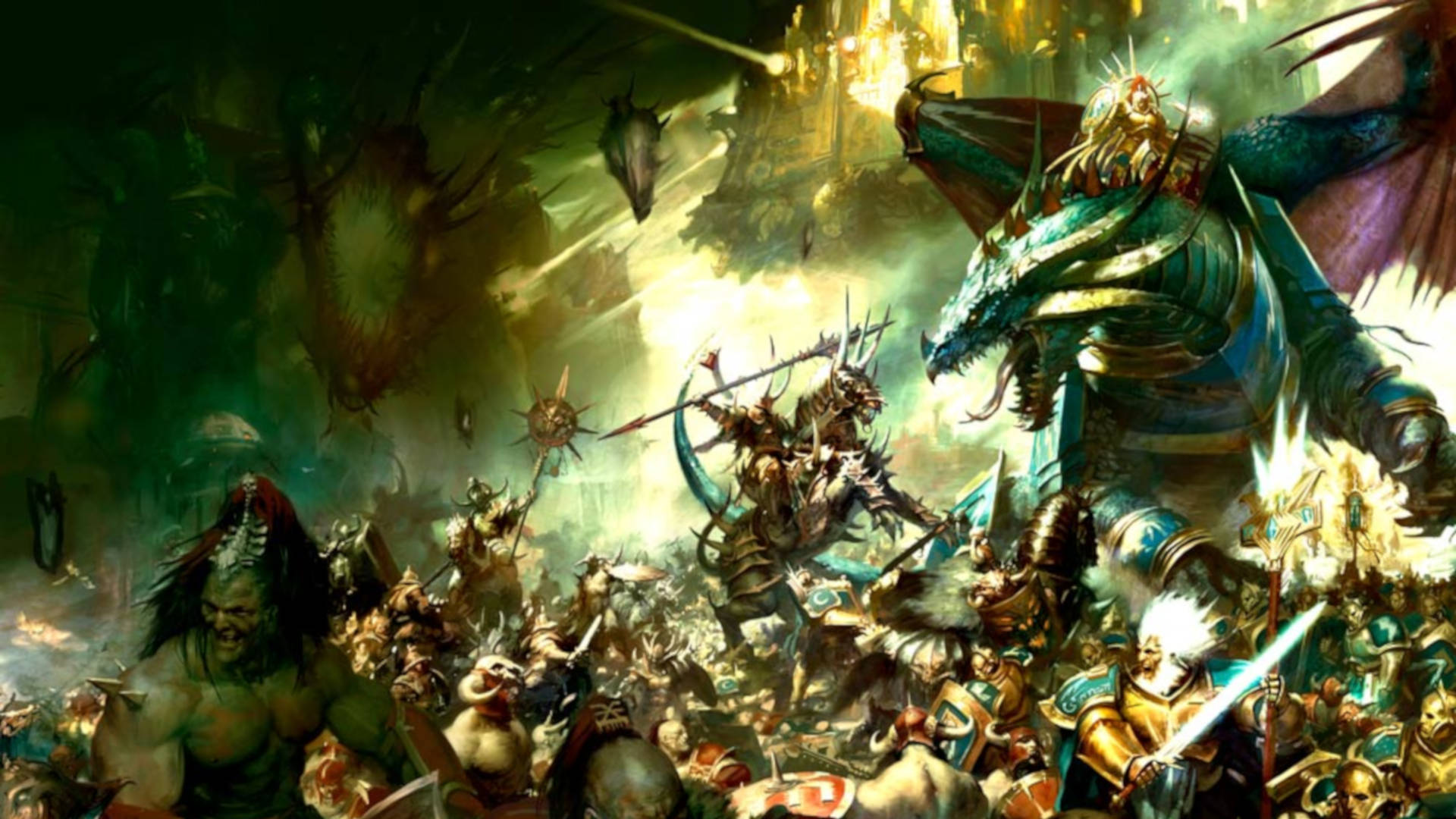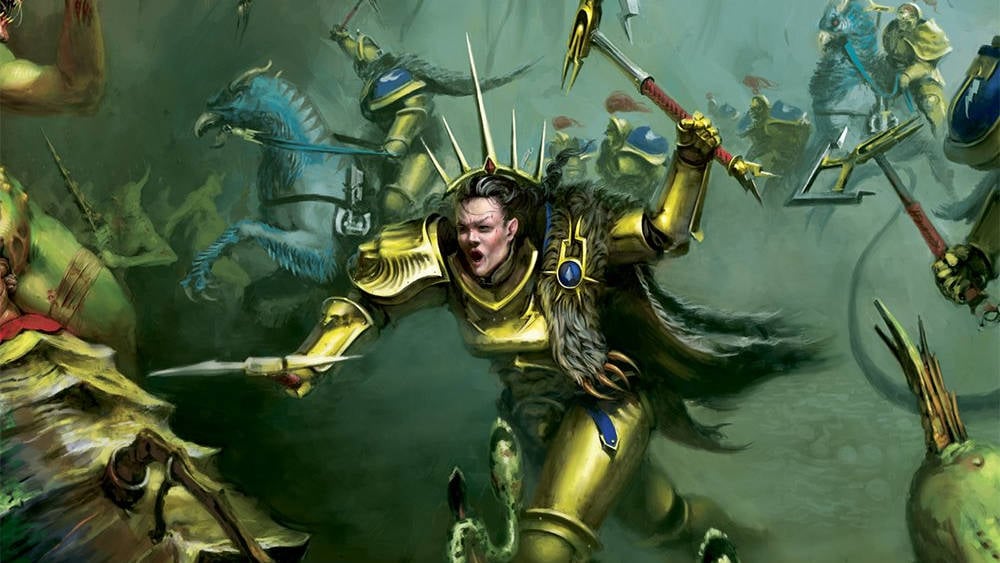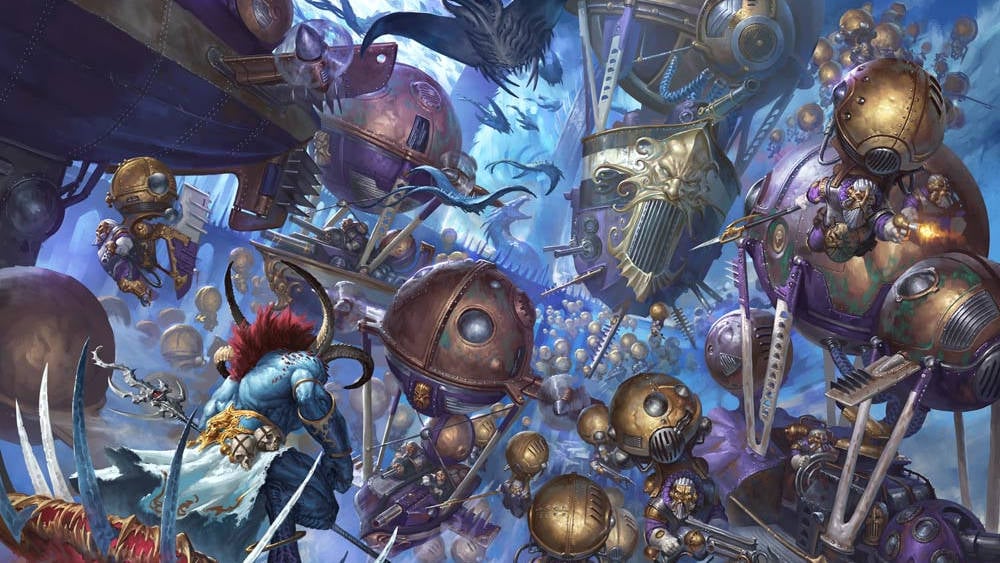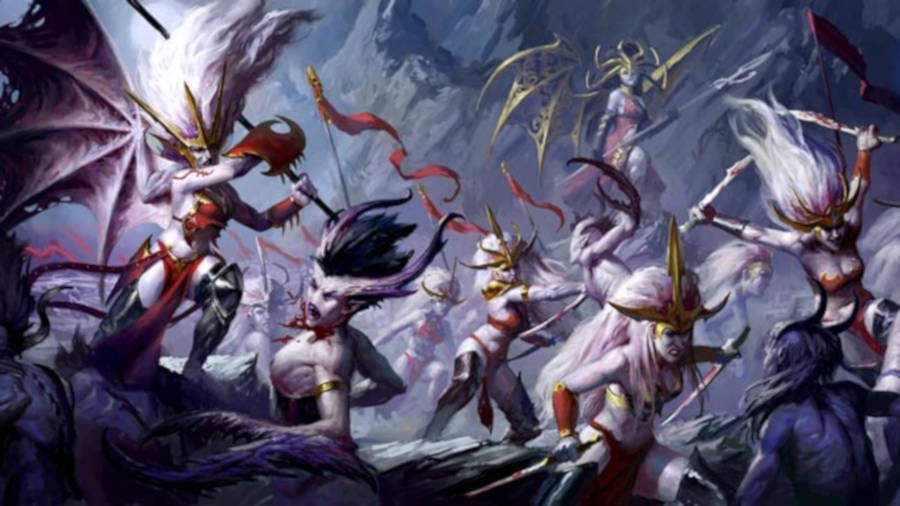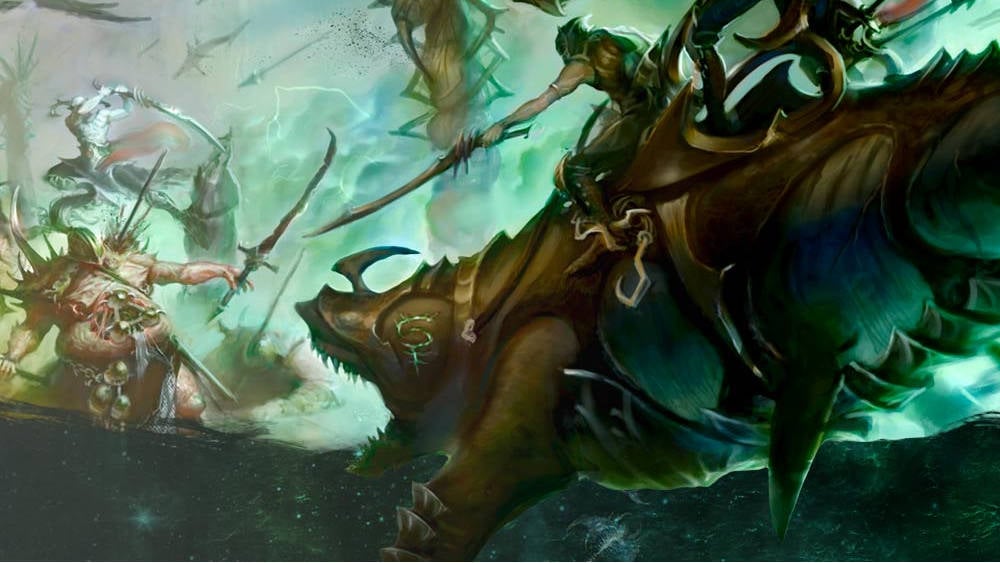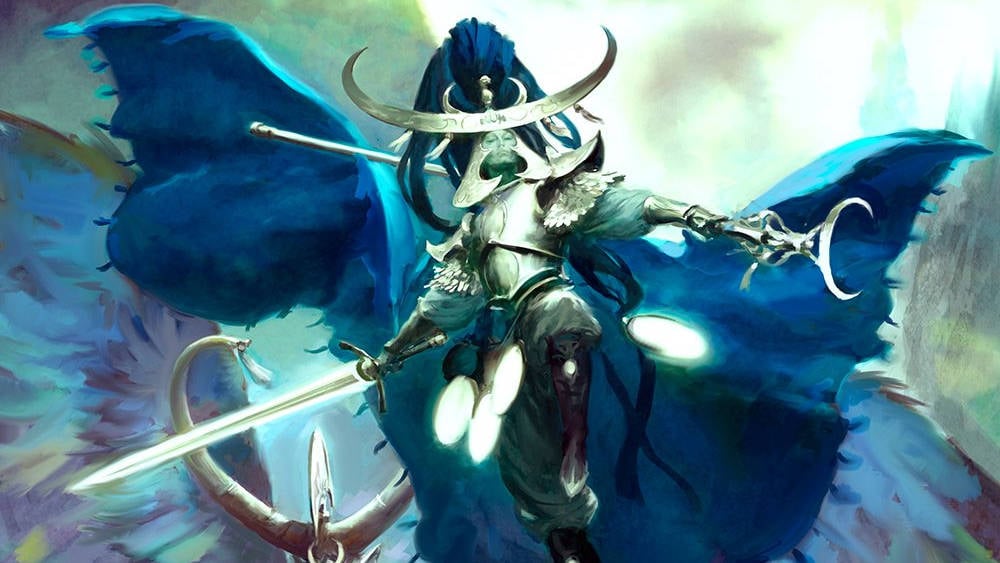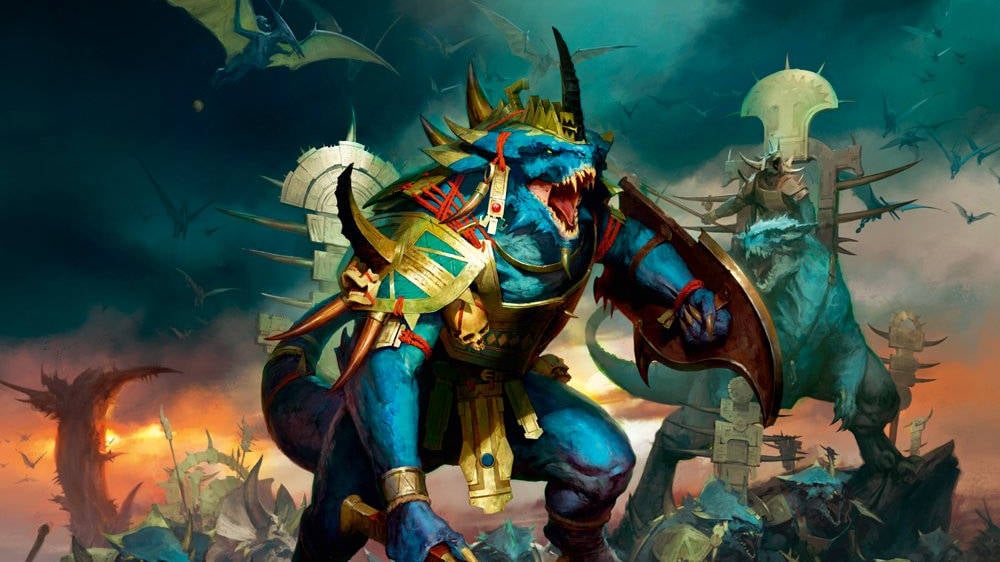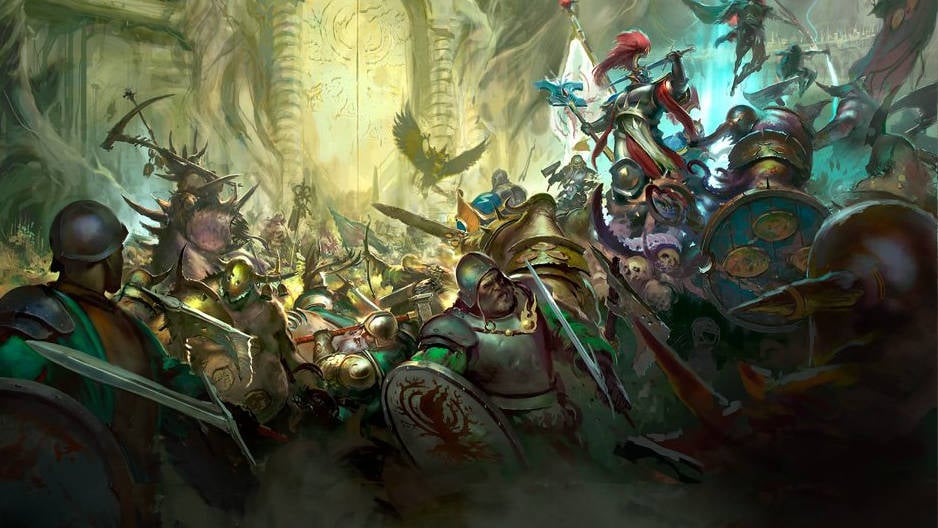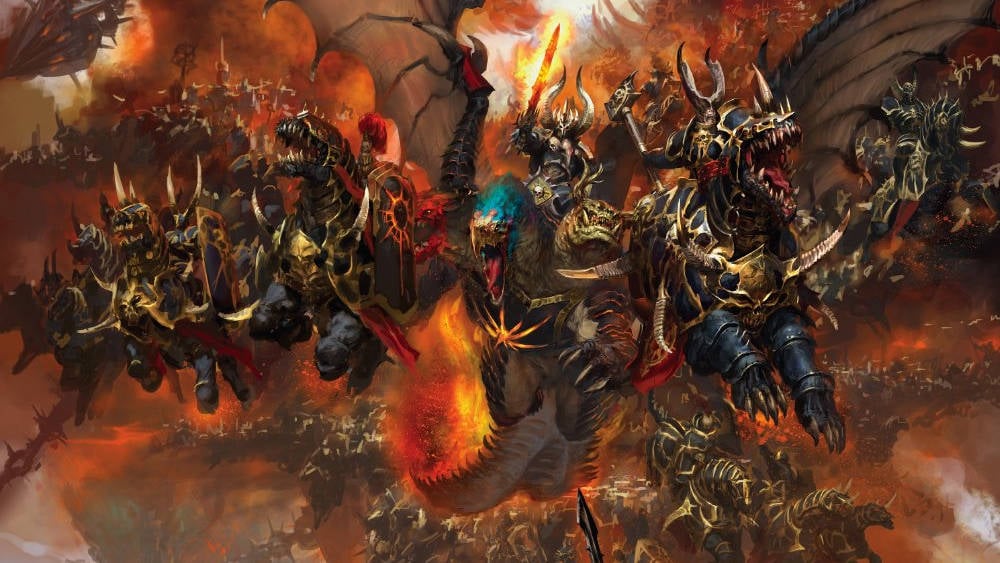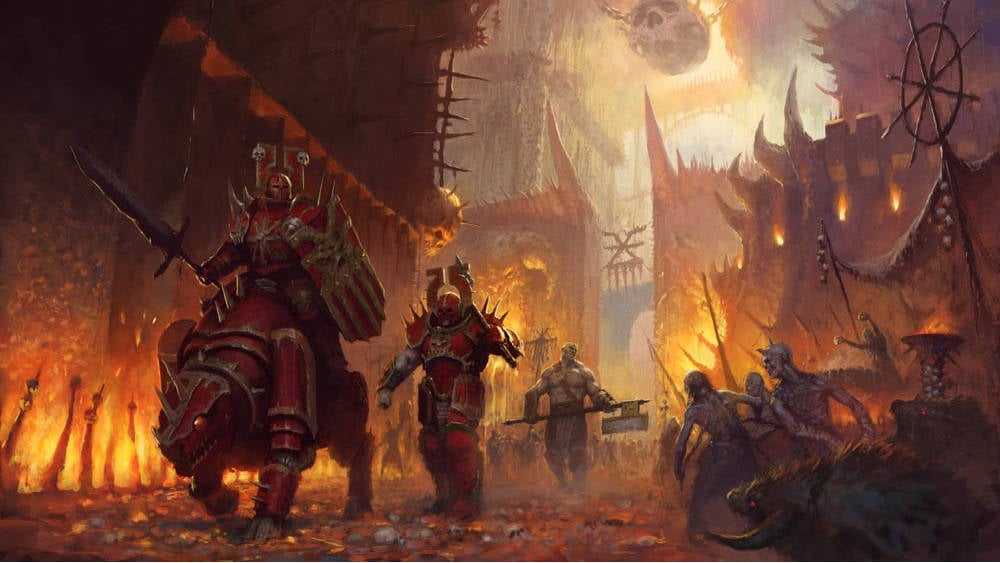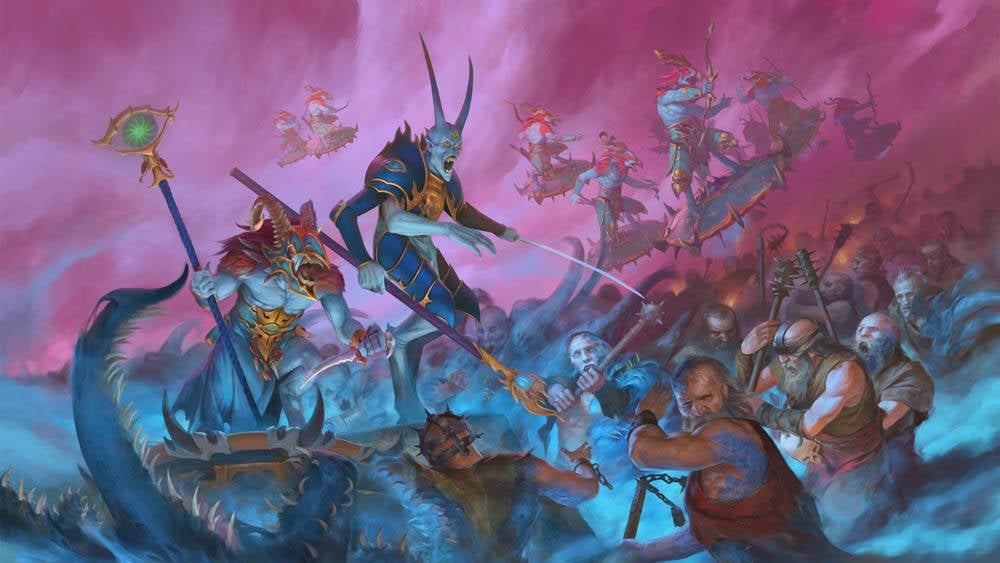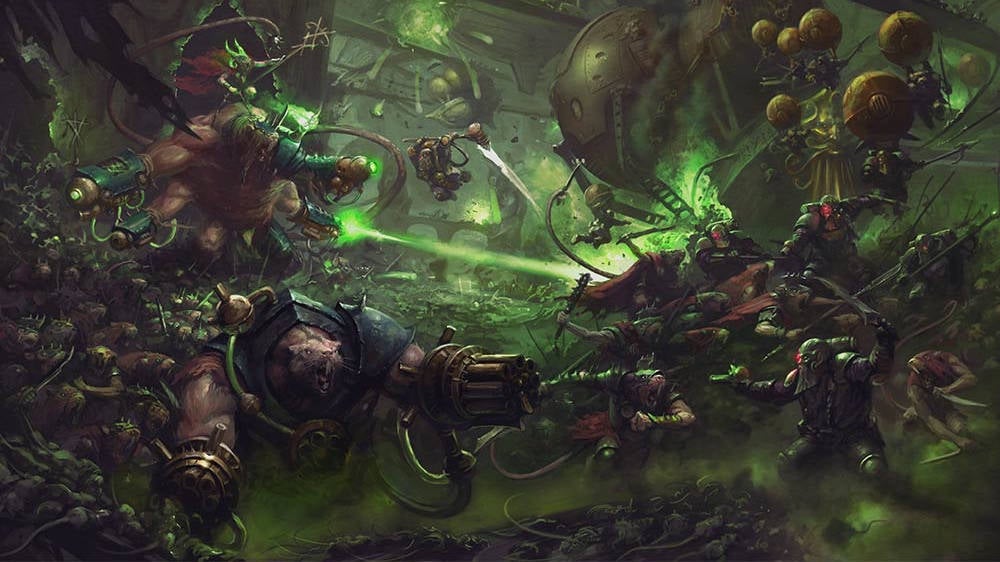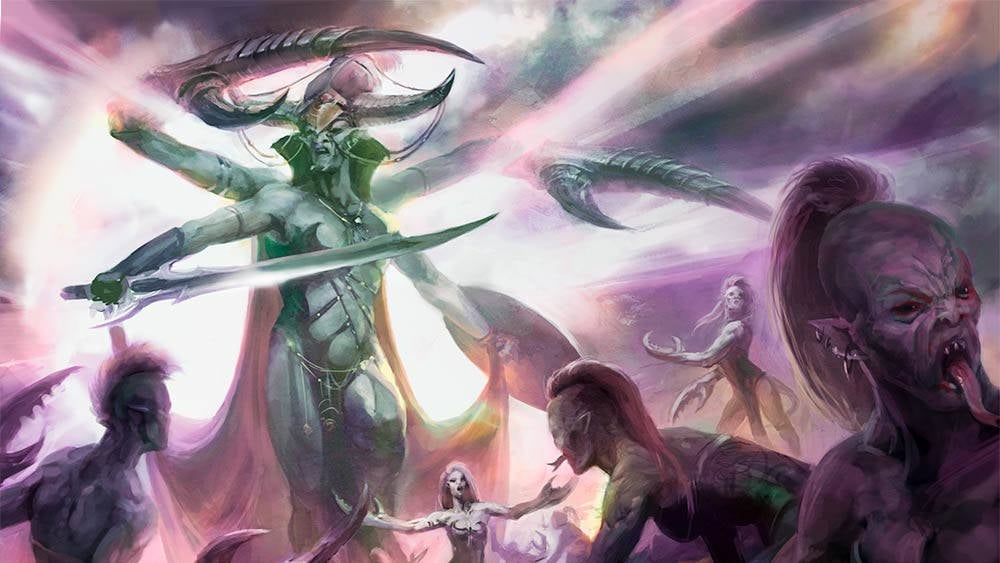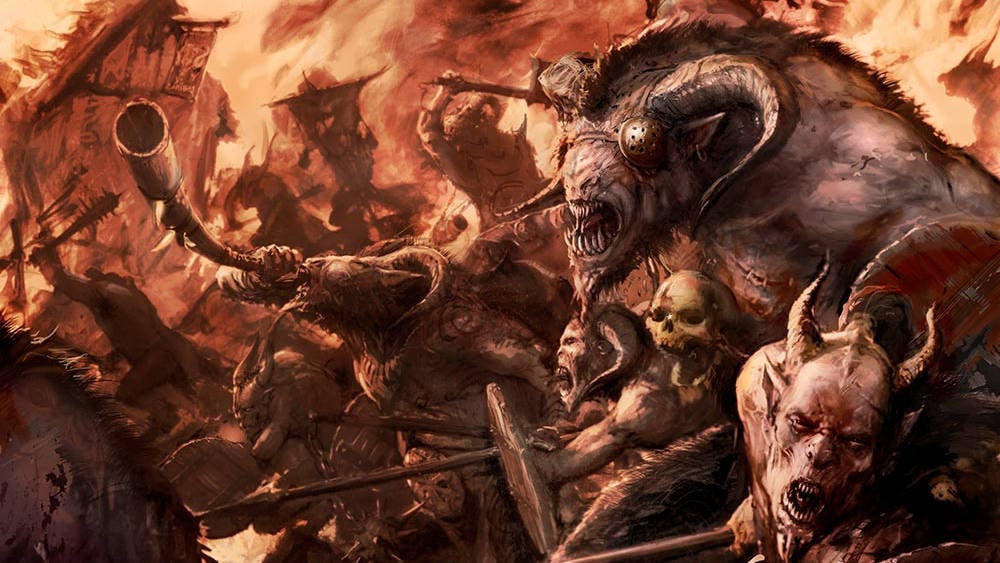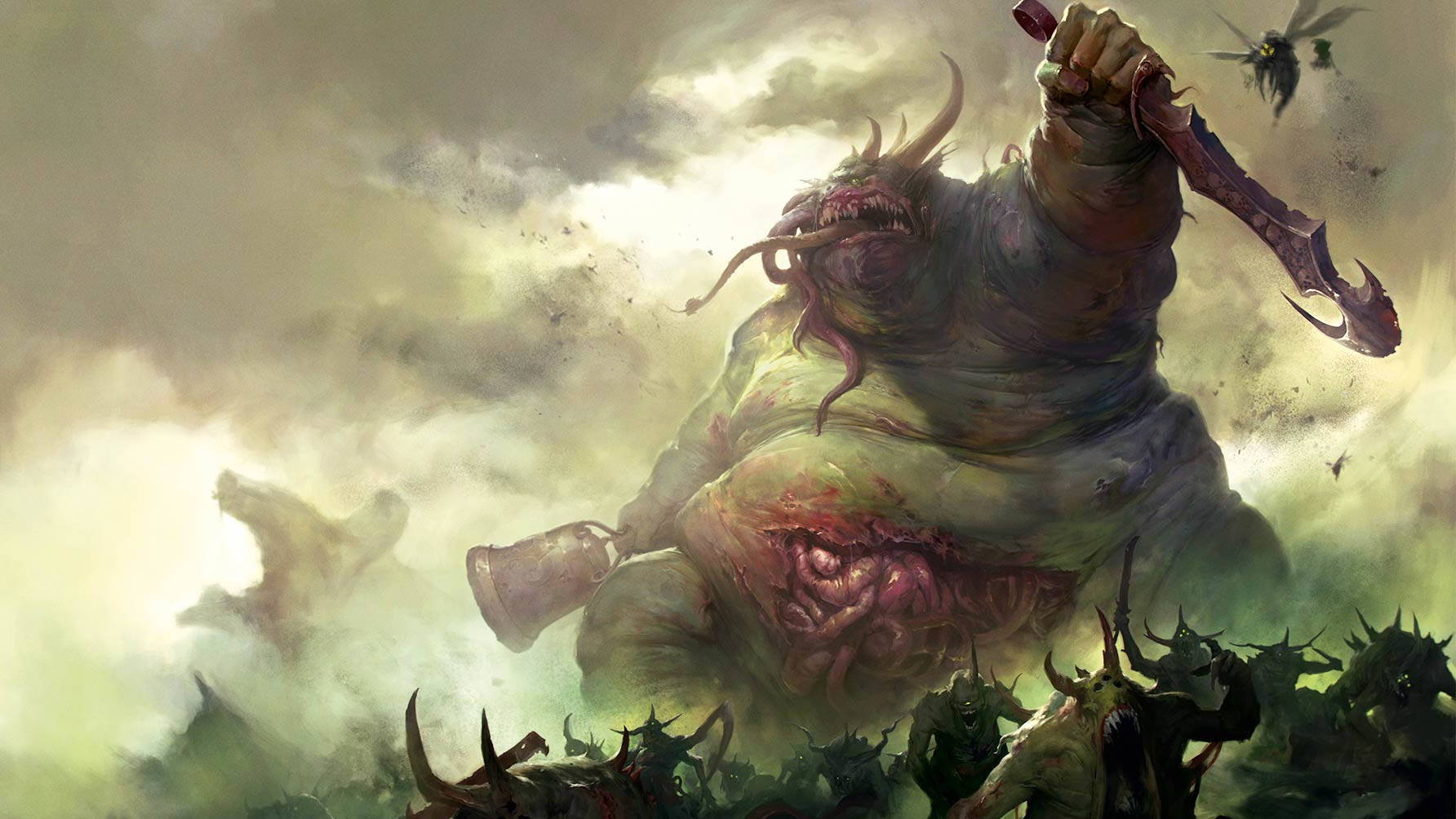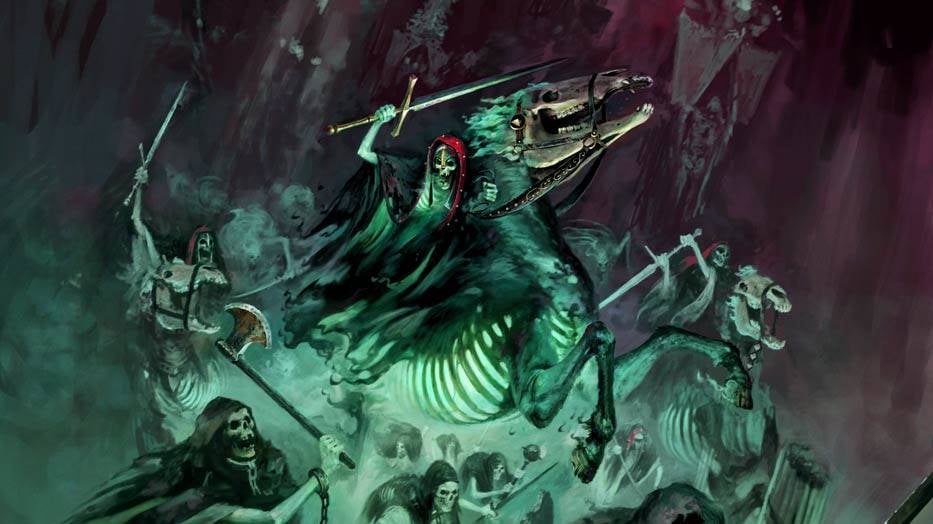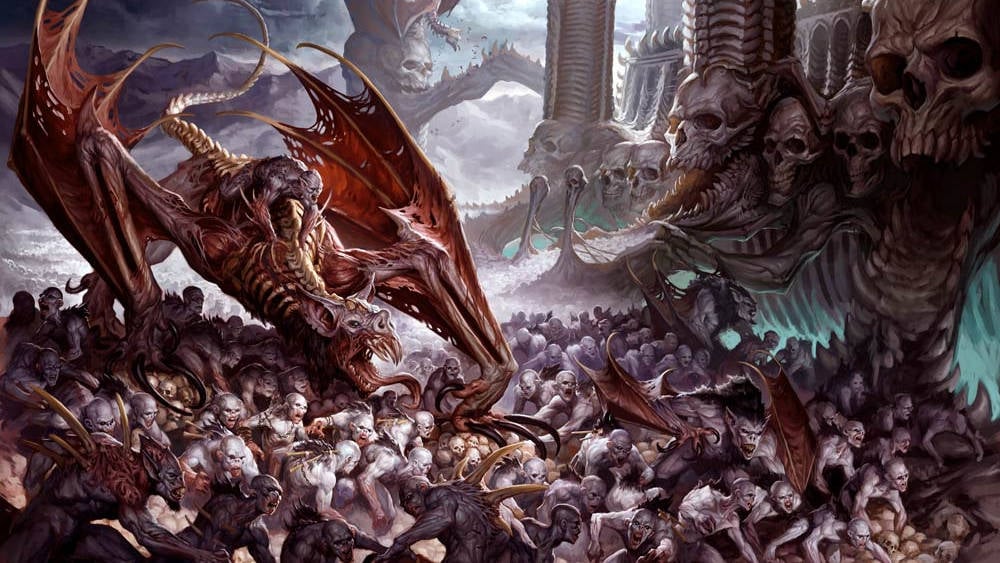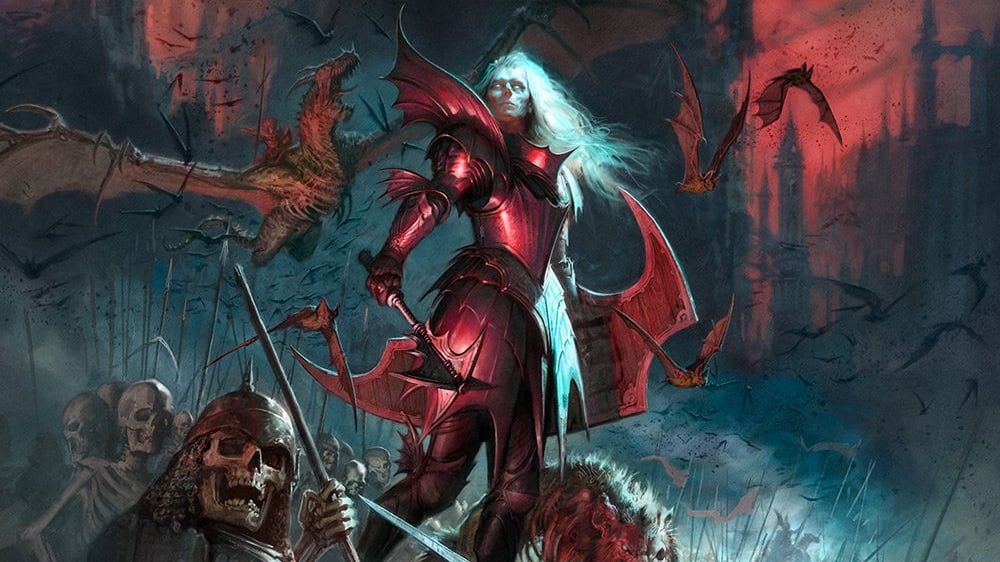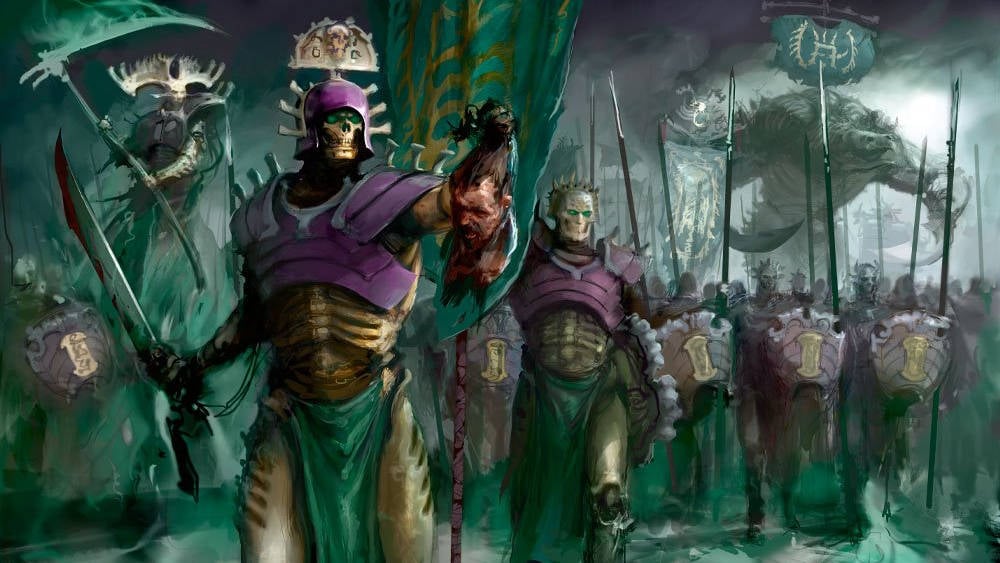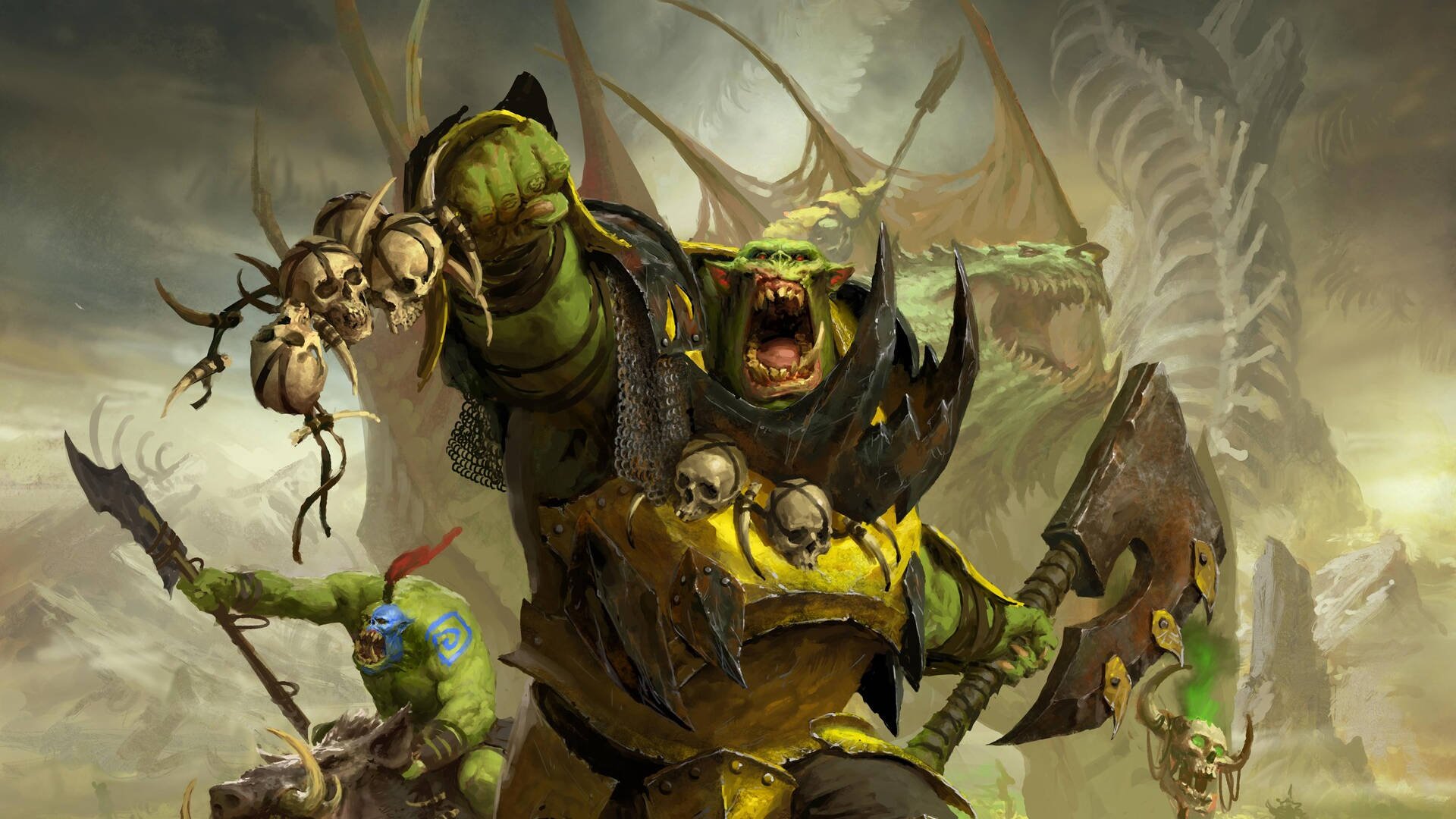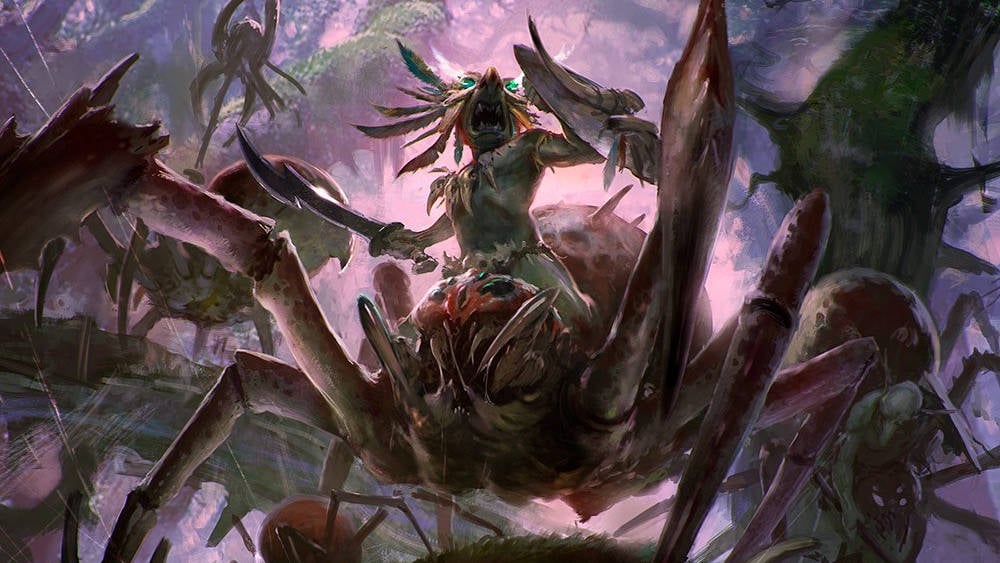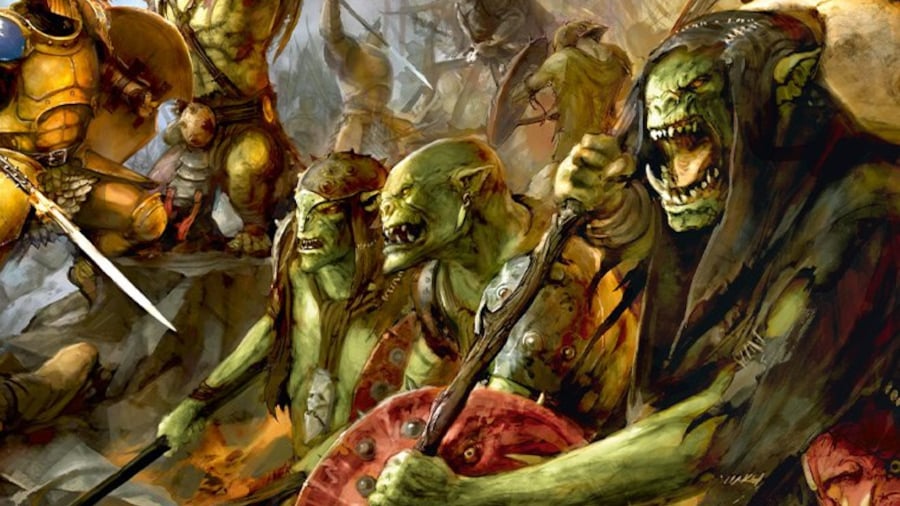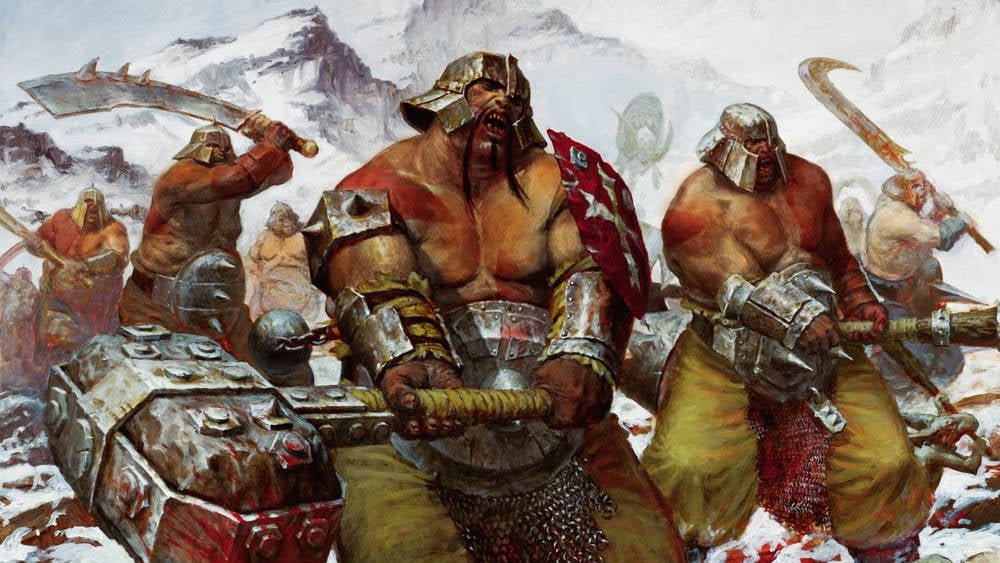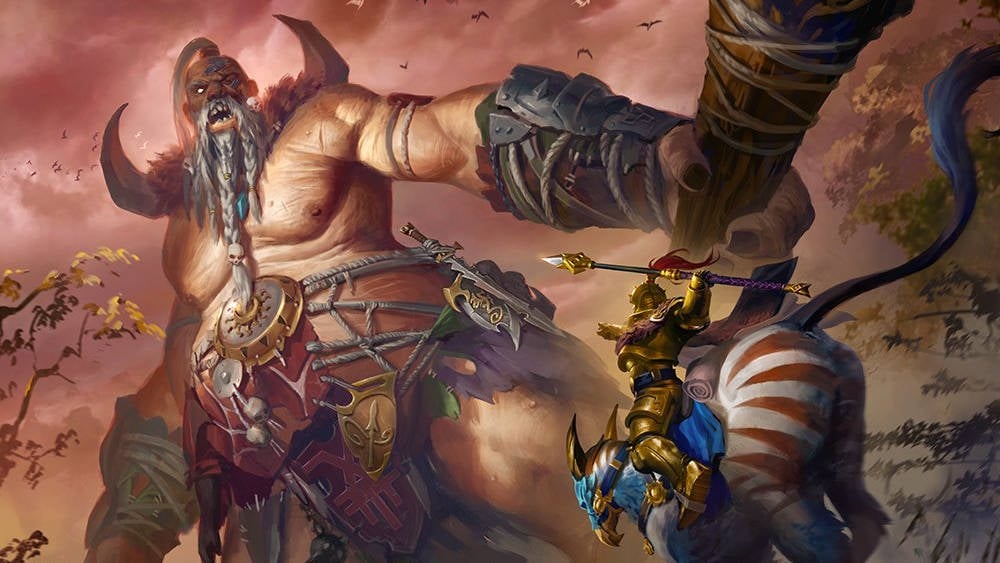Set in a dense fantasy world that stretches across aeons and contains an overflowing cast of characters, it can be hard work getting to grips with the Warhammer Age of Sigmar armies. Amongst all the sigmarite plate armour, elemental sorcery, and questionable tentacular appendages, it’s easy to feel lost. Well, banish your fears to the fourteen winds: we’ll walk you through everything you need to know.
Before we introduce the 20-odd Age of Sigmar armies warring for domination of the Mortal Realms, we’ll also show off some of the other great games you can play in this universe. We’re still waiting for the official Warhammer: The Old World release date, but plenty of Warhammer Fantasy videogames are also worth picking up alongside Age of Sigmar.
Age of Sigmar armies
This guide to Age of Sigmar armies features digestible summaries of each army’s most interesting features, both in lore and on the tabletop, summing up their possible attractions to the budding player or collector. You might fall in love with a couple, or decide certain factions are definitely not your thing, swearing never to gaze upon their sprues again.
Before diving in, it’s useful to know what to consider when picking an army. Of course, there’s each faction’s lore – the stories and mythologies that cement their place in the Age of Sigmar – and no one could ignore the enormous variety of unique miniatures each offers.
But different Age of Sigmar armies also cater to different playstyles. Some focus on fielding few, elite units that soak up damage and dish out fatal blows; others lean into sorcery to disrupt opponents and buff their own ranks, while more are purely melee-focused and crave the chaos of battle; and yet others are malleable to a host of options.
While none is strictly better than the rest, it’s worth your time to grasp what each army provides and consider whether you’d enjoy leaning into its playstyle.
When choosing an army in Age of Sigmar, it’s important to pick one that will provide longevity of entertainment. Go for an army that plays in a way you’ll enjoy, but also has a killer aesthetic you dig. Don’t let yourself paint your fiftieth grot before realising the Orruk Warclans aren’t for you.
Before we go further, let’s cover just how many armies there are to choose from…
Here’s a complete guide to Warhammer’s Age of Sigmar armies:
- The Grand Alliances of Chaos, Death, Destruction, and Order
- The Stormcast Eternals host
- The skyfaring Kharadron Overlords
- The Sylvaneth tree spirits
- The bloody-handed Daughters of Khaine
- The mercenary dwarven Fyreslayers
- The pelagic Idoneth Deepkin
- The magically attuned Lumineth Realm-Lords
- The saurian Seraphon
- The mortal hosts of the Cities of Sigmar
- The Chaos worshipping Slaves to Darkness
- The Blades of Khorne, servants of the Blood God
- Disciples of Tzeentch, followers of the Changer of the Ways
- The reality-gnawing Skaven ratmen
- The epicurean Hedonites of Slaanesh
- The primal Beasts of Chaos
- The jolly Maggotkin of Nurgle, bringers of plague
- The undead Legions of Nagash
- The spiteful Nighthaunt undead
- The maddened Flesh-Eater Courts
- The vampiric courts of the Soulblight Gravelords
- The militarised bonetakers of the Ossiarch Bonereapers
- The belligerent Orruk Warclans
- The moon-mad Gloomspite Gitz
- The slave-taking Kruleboyz
- The ‘eavy metal Orruk Ironjawz
- The gluttonous Ogor Mawtribes
- The towering Sons of Behemat
Grand Alliances
To start, a teensy bit of Warhammer lore is needed. All armies in Age of Sigmar belong to one of four Grand Alliances – Order, Chaos, Death, or Destruction. Each fights the others for domination across the multitude of inhabited worlds in the (current) Warhammer universe – known as the Mortal Realms – and brings its own moral compass, motivation, and proclivities.
Order chases stability, Chaos wants nothing but disruption and corruption, Death seeks to kill everything, and Destruction craves total anarchy and the unfettered freedom it brings. Each has its defenders and champions, enemies and foes, friends and allies.
For the sake of selecting an army, you won’t need to know the volumes of lore behind each of these alliances. Know only that whichever army you pick, it will belong to one of them and its role in the world of Age of Sigmar is influenced by this background.
And if you couldn’t care less about the fictional goings-on of Gods with names like ‘Khorne‘ or ‘Nurgle‘, feel free to look no further into it. You can still select an army, build your forces, field battles on the tabletop, and stare lovingly at your painted miniatures. You do you.
We’ll begin with Order – and with their most stalwart, shiniest champions, the Stormcast Eternals.
Stormcast Eternals
Pros
- Huge model range
- Balanced, accessible strategy
- Dragons
Cons
- Don’t excel in any one area
- The most ‘vanilla’ narrative choice
Collect them if…
- You’re new to miniature wargames and want a balanced force
- You like 40k Space Marines, but think they need some women
On the cover of every starter box and the modern poster-children of Warhammer branding, the Stormcast Eternals are Age of Sigmar’s answer to Warhammer 40k’s Space Marines.
Kitted out in shimmering sigmarite plate armour – complete with bulky shoulder pads and noble, facially-sculpted golden helmets – they’re the closest any army gets to being the ‘good guys’. Immortal warriors that ride down from the celestial plane of Azyr, Stormcast Eternals are the righteous souls of dead warriors, reforged by the God-King Sigmar into a holy force of magical marines.
Targeted towards new players wanting a smooth introduction to the game, Stormcast Eternals are easy to learn and offer a forgiving playstyle. An elite force of few units, you can command fearsome garrisons into battle without getting overwhelmed by tactical decision-making or strategic possibilities at your disposal, and their durability forgives any tactical faux pas that would put them on the wrong end of your enemy’s steel.
But they’re also a great army to grow into. Once you’ve tired of staring at clusters of hammer-wielding Sequitors or the magical Evocators, super-elite Paladins and an array of spellcasting Lords bring even greater abilities, which can be brought to bear to decimate the enemy. In many ways, the tough celestial armour of the Stormcast Eternals acts as a cushion – new players can have fun charging the battlefield, while more experienced generals can get to grips with their more nuanced abilities.
Discover even more with our Stormcast Eternals lore and tactics guide.
Kharadron Overlords
Pros
- Some of the best shooting in the game
- Their flying gunboats are powerful
- Strong narrative theme
Cons
- Infantry units move very slowly
- Relatively weak in melee
Collect them if…
- You love the steampunk aesthetic
- You want to play a mobile, shooty army
Steampunk dwarves (or duardin, to use their proper Warhammer title instead of the Tolkien vernacular) in flying ships. Not content with the murky interiors of mountain caves, these duardin took to the skies in blimps and floating fortresses powered by magical aether-gold to escape their crumbling cities, destroyed at the hands of Chaos.
Technologically-minded and doing their best to ape the chic aesthetic of sky pirates, the Kharadron Overlords come close to a Victorian’ inventor’s speculative perception of the 21st Century – all airborne inventions and rattling machinery. Their voracious appetite for profit, using their mercantile fleet to squeeze every last drop of gold from their traders, wouldn’t be out of place in Victorian Britain, either.
Although primarily composed of sailors and merchants, their forces are heavily armoured and laden with old-timey guns and cannons. Pound enemy defences with thunderous salvos, before using your airborne transport ships to move infantry to the frontlines and finish them off.
But don’t leave them stranded, as the stout duardin’s little legs won’t be fast enough to outrun most opposing forces, should an overwhelming counterattack come to call. Kharadron sky vessels, however, can scoop them up, disengage from battle and fly high above the fray to escape harm.
Get the hang of using your gunboats to bombard the enemy while keeping your duardin fighters in the right places at the right times, and you’ll find the Kharadron Overlords among the most powerful armies in the game.
For more info, check out our full Kharadron Overlords guide – or check out our Kharadron Overlords battletome review.
Sylvaneth
Pros
- Mobile and manueverable
- Good at magic
- Strong monster units
- Powerful synergies can make them very competitive
Cons
- Most units are vulnerable and go down easily
- High complexity – their best strategies require skill and planning
- Minimal board presence – you get relatively few models for your points
Collect them if…
- You love Lord of the Rings’ ents, but wish they were bloodthirstier
Sentient trees. Trees possessed by cognisant spirits that bring to life hulking trunks of bark, and bring with them a vicious thirst to destroy anything that dares defile their sacred woodlands.
From the sapling-sized dryads to the mighty Treelords, the Sylvaneth are primarily concerned with protecting the Realm of Life and seek to protect nature from corrupting forces. But they’re no eco-pacifists, and will happily slice and dice anyone they perceive as a threat with their sharp mahogany talons. Splinters will be the least of your problems.
On the battlefield, the Sylvaneth excel at hit and run tactics, appearing on the battlefield to surprise the enemy and dish out damage, then ducking away to safety. Teleport across the tabletop to out-manoeuvre your opponents by quickly redeploying melee and ranged units right where you need them, to exploit gaps in the enemy’s fumbling, inflexible ranks.
A big part of this is their unique deployment mechanics, including the option to place up to half of your army in reserve and bring in new units mid-game. Keep your opponent guessing and infuriated by your surprise assaults.
Daughters of Khaine
Pros
- Super fast moving
- Massive melee damage potential
- Good use of buff abilities can be devastating
Cons
- Very vulnerable, with 5+ and 6+ saves for most units
- High complexity; they require a skilled hand
Collect them if…
- You want a classic ‘glass cannon’ army that’ll either dominate or die
- You have a weird obsession with knives
Cultic followers of the aelven god of blood and battle, and followers of the sadistic, scheming Morathi, the Daughters of Khaine are a murderous gang of bloodthirsty rogues, delighting in fresh kills and spilling the blood of their enemies to momentarily satiate their merciless bloodlust and celebrate their god. Although they stand on the side of the righteous Stormcast Eternals, their allegiance stems more from a visceral hatred of Chaos than any genuine commitment to Order.
Quick-moving and agile, the Daughters of Khaine are one of the fastest armies on the table and revel in their ability to cut through enemy defences before your opponent can even begin to get a hold of the field.
Use knives and whips to torment enemies, bloodying them until they are exhausted into submission. A mixture of lamias, harpies, and other snake-bodied monstrosities, you’ll be fielding an intimidating fighting force of fierce (and murderous) women.
But, while deadly on the offensive, their units are weak and easily cut down. Lose the momentum of your army, or allow your opponent to establish a strong, central defensive line, and your knife-wielding butchers will soon be nothing more than sacks of flesh on the flocked floor. Dance around the battlefield and keep moving to stay alive.
Fyreslayers
Pros
- Tough, thanks to runic ward saves
- Very strong in melee
- Strong characters and monsters
Cons
- Slow moving
- Poor shooting and no magic
- Limited model range
Collect them if…
- You loved Warhammer Fantasy Battle’s Dwarf Slayers
- You enjoy naked, muscly little men
Muscular, bearded, and wearing naught but loincloths, Fyreslayers are warrior mercenaries fond of heavy axes and sick hairdos. Descendants of the fallen dwarf-god Grimnir, these duardin search the realms in pursuit of ur-gold, which they believe holds the fractured essence of their deity.
Smelting the gold into runes to graft onto their bare flesh, they gain preternatural strength that they incite in battle to crush enemies through sheer strength alone. They’ll sell their abilities to any bidder with enough ur-gold to satiate them.
On the tabletop, Fyreslayers are a straightforward army to play. Near-unmatched in melee combat, but with poor ranged abilities and a complete lack of magical inclinations, they have a simple tactical plan – get close and wreak havoc in hand-to-hand combat.
Meanwhile, the gargantuan Magmadroths they ride into battle not only look like hulking, fire-breathing beasts, but act like it, too, bringing the pain to any poor creature that finds themselves under their claws. Oh, and the colour red. If you’re going to start collecting Fyreslayers, make sure you’re in the mood for crimson, because you’ll be seeing (and painting) a lot of it.
Idoneth Deepkin
Pros
- Very distinctive, original theme
- Super fast
- Powerful (and spectacular) special units
Cons
- Not very survivable
- High points costs make this an elite army, with few units on the field
Collect them if…
- You have a deep and abiding love for the sea and all its creatures
If you’ve ever thought miniature wargames are lacking a formidable representation of fish or thought cavalry would be best replaced by flying sharks, look no further than the Idoneth Deepkin, Age of Sigmar’s resident Atlantean warriors.
Battling to steal the souls of their enemies, to fill the gaping voids that exist within their own beings and extend their cursed lives, these tragic, aquatic lovelies are visually the silliest army in the game, fielding a panoply of warlike ocean creatures, from giant turtles with gnashing teeth to giant, taloned sea horses.
An elite army that consists of few units, a single battle will see you control only a handful of units, tailored to breaking enemy ranks through brute force. But most novel is the ‘tide’ mechanic, which sees the Idoneth Deepkin’s combat ability change with the shifting oceans. One stage of the tide will provide cover to your units, while another lets them fight first in the combat phase, regardless of the usual activation order.
Not a hugely varied army, and their rules are tailored to do one thing well. But if you like their appearance, then you can surely make room in your heart for their playstyle, too.
Dive further into the depths of this army with a full Idoneth Deepkin guide.
Lumineth Realm-lords
Pros
- Highly competitive due to excellent magic and shooting
- Multiple subfactions offer lots of tactical variety
- A couple of mega-powerful characters
Cons
- An elite army which forces you to specialize lists carefully
Collect them if…
- You loved Warhammer Fantasy Battle’s High Elves
- You want to wield powerful magic spells
High aelves with amazing headwear. The Lumineth Realm-Lords combine the weaponry of a typical medieval army with powerful elemental magic. Cavalry lancers pierce enemy ranks, archers fill the sky with volleys of missiles, and pikemen form a tight defensive line, all while a colossal armoured spirit – half mountain, half cow (yes, as in the bovine, and endearingly nicknamed Battle Cattle) – swings a magical hammer the size of duardin skyship. Decked in gleaming white armour from head to toe, they’re staunch defenders of Order and will quell any corruption that crosses their path.
The Lumineth Realm-Lords are a real tactician’s army on the tabletop. Position your units resourcefully to weather your enemy’s charge and return a punishing missile attack. But they’re also powerfully magical. Every unit of your army, down to the humble archer, is magically attuned, capable of collectively dispelling enemy casts and boosting their strength to pierce armour.
If your history with Warhammer is seeing one ancient White Dwarf cover featuring Warhammer Fantasy Battles’ gleaming, pointy-helmeted High Elves and thinking ‘wow, those white and blue guys look cool”, then friend, welcome to the Realm-Lords.
Seraphon
Pros
- Actual dinosaurs
- Fantastic new model range released in 2023
- Some of the best wizards in AoS
- Great unit choices to contend in every turn phase
Cons
- Unless you field mostly Skinks, you’ll have a fairly low, elite model count
Collect them if…
- You love Lizardmen and giant magic toads
- You want to do some weird and wacky, colorful paintjobs
Anthropomorphic dinosaurs with a heavy dusting of Aztec aesthetic, these fierce reptilian warriors are leftovers from the world-that-was. Possessing an impassioned hatred for chaos, they direct all their predatory energy into defeating the corrupting forces and exacting vengeance for their lost homeland.
The Seraphon are one of the most versatile armies in the game. Nimble Skinks and hardy Saurus Warriors provide a solid infantry line, while living reptilian aircraft can swoop in to deal deadly crowd damage, and hulking earthbound dinosaurs are the centrepiece of the table. Whether you’re fielding the armoured Bastiladon or the triceratops-esque Stegadon, there’re enough scaly beasties to make Steven Spielberg jealous.
And they aren’t all sharp teeth and bludgeoning clubs. Powerful toad-like Slaan mages and lizardman Starpriests bolster the faction’s ranks, casting effective defensive buffs as well as deadly ranged spells. Or, save your spellcasting and invest in conjuration to channel your magic-users’ celestial attunement and summon new units to the battle.
The Seraphon are a lot of fun. Their gargantuan size, variable units, and vivid colours make them visually distinct, and the variability of play makes for some engaging tactics that beg for return and refinement. Plus, who doesn’t want to command rampaging dinos across the table?
Cities of Sigmar
Pros
- The newest, shiniest AoS army
- Huge choice of unit options including lots of spiffy new models
- Wide range of possible strategies depending on your focus
Cons
- Picking out a clear strategy and building a list can be overwhelming
Collect them if…
- You love 40k’s Astra Militarum and want to play them in fantasy
A hodgepodge of disparate mortal races, the name Cities of Sigmar is a unifying banner for all ordinary folk that seek to protect the last remnants of the Old World from the forces that would destroy it.
The weaker armies band together in walled cities, collecting their strength to stave off the overwhelming threats that mount against them. Humans fight alongside duardin and aelves, grabbing pikes, swords, runic weapons, handguns and anything else this plucky band of Order-loving folks can bring to the table.
No flashy deified lords or behemoths to field on the battlefield, the Cities of Sigmar get by on their diversity. Stick to an army of gunners in you’re so inclined, or mix it up with a smattering of aelven guardsmen and plodding duardin infantry. Mix some gyrocopters, arcane mages, and mythical beasts into the fray and you’ve got a bona fide potpourri of fighters.
Choosing one of the main free Cities from the Battletome (faction rulebook) can also give your army special rules and abilities, or even access to some other factions’ units. A great pick if you’re after variety above all else and want an eclectic bundle of sculpts to lay on the tabletop.
Slaves to Darkness
Pros
- Strong melee fighters all
- Huge model range to choose from, with wildly different strategic options
- Marks of Chaos buffs add flexibility and synergies to line troops
Cons
- Not the best at any one thing
- Not great at magic
Collect them if…
- You love metal music
- You want to play as the baddies
And so begins our journey through Grand Alliance Chaos.
Previously known simply as Chaos Warriors, the Slaves to Darkness are – at least most of the time – the clearest ‘bad guys’ of the piece. Zealot worshippers of the Chaos gods, these hefty mortal warriors clad themselves in thick, black plate armour decked out with horns, skulls, and an assortment of other trinkets that let everyone know they are just so evil, and don’t you forget it.
Their poster-boy is the illustriously-named Archaon the Everchosen, champion of the four Chaos Gods and literal destroyer of worlds, who will ruthlessly slay lords and deities to advance the corrupting forces of Chaos. He ain’t playing around.
Central to Age of Sigmar lore, the Slaves to Darkness have a massive array of units at their disposal. You can form lines of evil black knights that hold their own in any melee, or raise a horde of marauding barbarian tribes, and even supplement them with feral chaos creatures with enticing names like “Slaughterbrute” and “Mutalith Vortex Beast”.
The army is geared towards standard close-combat – beefy units marching to the enemy, launching crushing melee attacks, while enemy blows bounce like pebbles off their magic-imbued battle armour. Hero units that look incredible and play well – from typical Chaos Lords to Daemon Princes – bring massive spellcasting capabilities that are easy to slot in. With few ranged units, though, be prepared for close quarters and the bloodiest view of war.
Blades of Khorne
Pros
- Pretty fast
- Blood Tithe rewards you when your units die
- Lots of hard counters to whatever you’re facing
Cons
- Not as deadly as they feel like they should be
- No magic, and prayers aren’t as good
Collect them if…
- You really like metal music
- You favor very aggressive play
Like the sound of Slaves of Darkness but want a little edge to your nefarious warring? Consider the Blades of Khorne and their daemonic forces for your next tabletop fancy. Crimson Bloodletter daemons, adept in gouging the vital organs of others in melee combat, rush to the frontlines of conflict, supported by a satanist’s dream dinner party of other devilish creatures – complete with pointy horns, serpent tongues, and bat wings. Other mortal cultists are along for the ride, sporting big axes and big abs.
Subtlety has never been Warhammer’s watchword, and this army doesn’t know the meaning of it. Charge forward, hit anything you touch, rinse and repeat. With no ranged or magic units (the blood-god Khorne can’t stand either), and little defensive capabilities, they’re all about the attack. Stay on the attack, never give up the attack, and sure as hell don’t retreat, and you’ll probably do fine.
Disciples of Tzeentch
Pros
- Superb magic
- Strong ranged options
Cons
- Low survivability and toughness
- High complexity – you’ll need skill to pilot them well
Collect them if…
- You believe there is no good or evil; only the pursuit of truth
- You really like birds
Tzeentch is the Chaos God of Change, a schemer who relies on masterful sorcery to upend the natural order of things and manipulate the rules of the game. Often, this involves growing a new limb on the side of your body or sprouting some new eyes on the side of your head. The somewhat lighter side of Chaos, this army is full to the brim with brightly-coloured, capering Horrors and corrupted humans spliced with the heads and appendages of other animals.
A very magic-focused army, they have dozens of spells at their disposal to turn the tables in their favour. This might involve a few essential buffs, or even more brazen moments of trickery as you manipulate the dice. Also one of the few Chaos armies with respectable ranged units, the Disciples of Tzeentch tend to mix magic and missiles to secure victory.
Skaven
Pros
- Fantastic narrative backing infused with silliness
- A fun mix of powerful heroes and huge, dirt-cheap hordes of rats
- Good subfaction variety, including some strong shooting
Cons
- Almost all your units are super vulnerable to damage
- Horde units are weak to battleshock and will run away easily
- Some of the oldest, ugliest Warhammer models around
Collect them if…
- You want to flood the board with rats
- You don’t mind fielding minis that already looked old hat in the 90s
Rat men. Humanoid rats that bring all the stink, pestilence, and wretchedness you’d expect from such a verminous race. Individually, they’re yellow-bellied and bitter, but they band together to form a domineering force of shocking strength and matted fur. T
hey’re not all dumb rodents, though. Technologically inventive, the Skaven clans wield deadly inventions – from handheld bombs, to gatling guns, to lightning cannons – alongside arcane sorceries, and monstrous mutated, beastie-boy rats that hulk across the field to stamp warriors and chew flesh.
Very much a horde army, Skaven send barrages of rats to overwhelm enemies and use pernicious condition attacks, like poisons and plagues, to chip away at their health. But be wary of your gutless troops, as they’ll turn and flee at the slightest retaliation – so rely on specialists to supplement the underlings.
Skaven lean into the fun side of Age of Sigmar. Snivelling rats that come in all shapes and sizes, their repulsiveness is as entertaining as their in-game strengths, and their striking (if often gross) larger models make for great sculpts to display off the battlefield, too.
Yes-yes, there’s more – here’s a full Skaven guide.
Hedonites of Slaanesh
Pros
- Some of the weirdest, most impressive Warhammer models ever
- Incredibly fast moving
- High damage potential, aided by temptation rolls
Cons
- Glass cannon army that’s very vulnerable – both to enemy attacks and swingy dice
Collect them if…
- You love the color lilac, and also crab claws
- You want to play fast paced games where you win or lose quickly
Zipping about the battlefield, cutting enemies down before they’ve had a chance to glimpse the clawed appendage that sliced them, the Hedonites of Slaanesh are all about speed.
Quick and graceful, these intoxicating, gender-bending daemons hit enemies fast and hard, hoping to deal enough damage in a first strike to leave the enemy so weakened they can’t muster the strength to cripple your precarious defences. Use speed to out-manoeuvre your opponent and run them in circles until you can launch your final, exquisite killing strike.
A fairly recent addition to Age of Sigmar, there aren’t masses of unit options available to build your army, and you’ll likely be fielding a mix of Daemonette infantry and Hellstriders – but their sub-factions make for some varied playstyles. Check out the latest Hedonites of Slaanesh battletome review to hear about them.
Arrogant, elegant and probably fragrant, the sexy, sensation-obsessed daemon children of the Dark Prince Slaanesh are a fantastic choice for anyone eager to subsume themselves into the welcoming arms of Chaos, but not keen on the butch machismo of the other gods’ armies.
Beasts of Chaos
Pros
- Flexible and mobile
- Lots of clever synergies to be found
- Fantastic fodder for model conversions
Cons
- Most units die pretty easily
- Some very old models in the range
Collect them if…
- You like Mister Tumnus from Narnia, but wish he had an axe
Horns, hooves, and snouts – the Beasts of Chaos collect all the Chaotic fauna roaming the Mortal Realms under one banner. Some are savage human-like creatures with preternatural strength, others are chunky boulder-wielding behemoths, and still more are mutated chimerae, sprouting animal appendages from every orifice. They all share one common, simple goal – to destroy all civilisation until nothing remains but anarchic Chaos.
A huge – if mostly quite dated – range of models that look imposing on the tabletop, these aren’t the lumbering beasts you might expect, but fast-moving brutes that gallop up to the enemy’s frontline to get into a scrap. While not the most effective fighting force – with comparably weak attacks and fragile defences – the creativity of their models should be enough to pull you in if you like the idea of hoof-based warfare.
Maggotkin of Nurgle
Pros
- Probably the toughest AoS army
- Survivability and simple tactics make them very accessible
- Decent, steady damage output (especially mortal wounds)
Cons
- Incredibly slow moving
- Terrible at ranged combat
- Limited unit choices
Collect them if…
- You have a strong stomach
- You want to do some truly disgusting paintjobs
All blighted skin and pus-filled abscesses, the Maggotkin of Nurgle are loyal followers of the Plague God Nurgle, who devotedly spread his many poxes across the Realms. Organs spill out from the gaping holes in their flesh, and hideous tentacles pierce their putrid sides. When they’re not checking out what cool new medical afflictions have cursed they’re bodies, they’re busy gouging out the eyes of enemies (it makes more room for maggots).
Apart from being gorgeously disgusting to look at, they also pose a formidable combat force. Massive daemon-spawn bring the scale you’d expect of any Chaos army, swinging swords or vomiting acidic bile, and the ‘noble cavalry on trusty steeds’ are mouldering Plaguebearer daemons, flying giant, plague-swollen mosquito mounts into battle to spread unholy contagion.
Physically decaying but imbued with their patron god’s fecund, regenerative power, they’re resilient to attacks and hard to kill for good, while leveraging the magic of their spellcasters for powerful damage combos. Ultimately, though, you do it for the sculpts – if you can hold down your breakfast while looking upon them, they are truly incredible.
Nighthaunt
Pros
- Lots of strong, distinctive units with powerful stacking buffs
- High speed and mobility; every unit can fly
- A few super strong characters
- Some of the best character models in Warhammer
- Super easy to paint beautifully using contrast paints
Cons
- Weak armor saves, relying on ghostly wards instead
- Completely dependent on keeping your heroes on the board
- Most models are super fragile and break easily in transit
Collect them if…
- You really like skulls, chains, and Edgar Allan Poe
- You want to paint a whole army quickly and easily
A spectral army of scythe-wielding and sword-toting apparitions, the Nighthaunt is the elite vanguard of the Great Necromancer Nagash, gliding across the battlefield to bring all living things the cold touch of death.
Clad in black hoods that morph into their ghostly lower halves, they bring cavalry, wraiths, and all manner of see-through soldiery to the field, all of them filled with an eternal hatred of those goody-two-shoes Stormcast Eternals. Hard-hitting and tough to kill (how do you kill a ghost, after all) the Nighthaunt are another forgiving army that’s easy to pick up but challenging to master.
Ignoring fatal wounds keeps their unit count high, and flying means they can circumvent enemy lines to pick off the defenceless. Although packed with hero units to support a solid frontline, keep them well-defended or the destruction of those figureheads will leave the rest of your force dissipating into so much harmless vapour.
Our Nighthaunt guide has way more detail on the hideous heroes and spectral strategies of this army.
Flesh-Eater Courts
Pros
- Simple, accessible strategy
- Brand new model range coming out in early 2024
- Probably the best backstory in all of Age of Sigmar
Cons
- Weak saves; most units go down easy
- Barely any shooting options
Collect them if…
- You enjoy gory horror movies
- You get a kick out of a tragic backstory
Slavering, cannibalistic ghouls that got on the wrong side of Nagash, the Flesh-Eater Courts have long been afflicted with tragic delusion that they are whole, living creatures organised into noble, royal courts.
Thinking themselves kings on thrones, chivalrous knights pursuing noble deeds, storied pennants fluttering, et cetera, they’re permanently unaware of their grotesque forms and bestial, flesh-eating proclivities.
Rotting skin, flesh-eating monstrosities, and abominable bat-like horrors hallmark the Flesh-Eater Courts, who surge across the battlefield in packs of feral infantry, interspersed with great skeletal beasts.
Possessing some of the more powerful summoning abilities among the armies of Death, they can maintain enough units to wear down the enemy – and you’ll need to bring a lot of them, since these misshapen sacks of flesh have weak saving throws. With no ranged units, you’ll be relying on your spellcasting and heavy creature attacks to make major dents in the enemy.
On the upside, as of 2024, you’ll also have access to some of the most gloriously characterful minis in all of Warhammer – including the grisly Grand Justice Gormayne and the massive, revenant ghoul king Ushoran.
Soulblight Gravelords
Pros
- Good range of different tactical options, based around a core horde structure
- Undead horde units can be strong when supported with hero buffs
- Fantastic looking new model range released in 2022
Cons
- Highly dependent on keeping your vampire leaders in play
Collect them if…
- You love skelebobs and zombos
- You main Vampire Counts in Total War Warhammer 3
Aristocratic vampires who are as monstrously macabre as they are pallidly chic. These bloodsuckers are cursed to forever lust for sweet, sweet drops of blood, and serve the will of Nagash in exchange for monstrous powers and inhuman strength. Descended from ancient bloodlines, the Soulblight Gravelords are split into various dynasties that stem from powerful matriarchs and patriarchs – all with their own heraldries and themes, of course.
Under these vampiric leaders are vast legions of undead fiends, raised in shambling warbands to crush the life from the Mortal Realms. Functionally, this means the Soulblight Gravelords rely on swarms of Deathrattle Skeletons and Deadwalker Zombies to bulk out their ranks, while pepperings of elite glass cannons swoop in for sporadic, but massive damage.
There’s also a heavy emphasis on theme. The army’s five subfactions greatly differ in playstyles, and the gorgeous Soublight character models, each one belonging to its own dynasty, are intended to be paired with a specific bloodline and units. The half-wolf Belladamma Volga provides support boosts to Dire Wolves, while Lauka Vai, Mother of Nightmares betters suits push-your-luck offensive play. There’s masses of room for versatility guided by thematic rulesets. Plus, the miniatures look amazing.
To learn everything you need to know about these pale-faced killers, read our complete, ghoulish Soulblight Gravelords guide.
Ossiarch Bonereapers
Pros
- Some of the best battleline units in the game
- More survivable than other Death armies
- Army rule lets you ignore command points, using your own secret sauce instead
Cons
- Slow moving
- High complexity, with lots of overlapping rules to learn
- Limited model range
Collect them if…
- You want to cosplay as an entire army of Skeletors
The martial Ossiarch Bonereapers are the closest the alliance of Death comes to refinement. Dispensing with the shambling skeletons and disorganised zombies that hallmark other armies, this faction offers tough, disciplined troops that can be trusted to hold the line and follow orders. They represent Nagash’s intended transformation of the Mortal Realms – the perfection of his deathly touch, in the form of elite enforcers made from magically-reforged bone and strong armour.
A tanky army that’s durable to attacks and shrugs off blows without a second thought, they leverage combos of powerful abilities to deal high damage in quick succession. Reanimated human and other remains are still very much their main motif, but they’ve also got a chic Egyptian-theme going on, with a touch of east Asian design thrown in to prove it’s not entirely just a re-skin of Warhammer Fantasy’s ever-popular Tomb Kings.
With lots of intricate sculpts, the Ossiarch Bonereapers will test your painting skills and have you highlighting more human ribs than you thought possible.
Check out our Ossiarch Bonereapers guide for a full examination of these bony boys.
Orruk Warclans
Pros
- Huge variety among subfactions, models, and strategies
- Buckets of personality and lots of brand new models
- Except for the goblins, all your units are fairly tough
Cons
- Extremely slow movement except for a few boar cavalry units
- Your magic and shooting are mediocre at best
Collect them if…
- You want to play Warhammer 40k Orks, but in fantasy
Enough of this fancy-pants, good and evil nonsense; it’s time for some good old fashioned smashin’, as we examine Grand Alliance Destruction, starting with its keenest, and indeed greenest proponents, the Orruk Warclans.
Typical greenskins. Aggressive, muscular, and beastly, with thick skulls and sharp tusks, many orruks clad themselves in brightly painted sheet metal armour, while others incite shamanic rituals to call down the winds of magic and enhance their fighting ability. Always on the hunt for big prey, these Waaagh!-hungry monoliths of muscle will throw themselves into the throes of combat to prove themselves to their chosen gods – the deceptively poetic Gork and Mork.
The current ‘Orruk Warclans’ force is an amalgamation of three Age of Sigmar armies – the Bonesplitterz, Ironjawz, and Kruleboyz. Players can field an army aligned to one or the other to incur specialised abilities and form a more directed playstyle, or pledge allegiance the Big Waaagh! and put aside tribal differences for the sake of the slaughter. Their abilities are designed to accelerate the offensive and rewards players for risky assaults.
This army isn’t for hesitant players who care for the safety of their troops, but those preferring to plunge their forces in the heart of a melee. Big, boisterous, and loud. Make sure to buy lots of green paint.
Gloomspite Gitz
The Orruks’ shorter, skinnier, but no less deadly cousins, these conniving backstabbers kit out their forces with a selection of creepy creatures, and worship a partially-sentient planetoid, The Bad Moon, vying for its affection and celestial power.
Snivelling grots, rotund squigs, cumbersome troggoths, and fearsome giant spiders, the forces of the Gloomspite Gitz are perhaps the closest Age of Sigmar comes to slapstick comedy. Yes, they’re wicked and slimy creatures that won’t think twice about spilling your guts on the floor, but there’s something hilariously endearing about a goblin shaman struggling to balance on a walking toadstool.
Another versatile faction, the Gitz can be played as a horde army to overwhelm the enemy through sheer volume of units, a magic army that concentrates on damage-dealing spellcasters to turn enemy forces into goop from afar, or a cavalry-led force charging headfirst into the fray on their many-legged mounts. They also make for great painting, with a variety of cartoonish sculpts to draw every eye on the battlefield.
You can find even more tasty titbits in our full Gloomspite Gitz guide.
Kruleboyz
Introduced in Age of Sigmar’s third edition launch box, Dominion, the Kruleboyz are another faction of Greenskins. While the other Orruk Warclans are beefy and bellicose, and the Goomspite Gitz rabid and rowdy, this lot are cunning and devious. Hiding in swampy bogs, they were unknown to most players in the Mortal Realms, only revealing themselves to follow the ancient deity Kragnos in his destructive rampage.
In our full Kruleboyz tactics guide you can find out how to be kunnin’.

Orruk Ironjawz
The Orruk Ironjawz are the most brutally simple of the Orruk Warclans. Clad head to toe in beaten metal armor, they often ride massive Gore Grunta pigs or Maw-Krusha wyverns into battle. Ironjawz eschew ranged weapons in favor of point-blank violence. Their model range is being updated currently, the highlight of which is definitely the massive new Maw-Grunta – the biggest pig in all the realms.
Ogor Mawtribes
Pros
- Your units hit like a truck when they charge
- Everything’s relatively tough and survivable
Cons
- Second most elite army, so you’ll not have many models to play with
- Limited model range
Collect them if…
- You want a simple playstyle focused on bonking enemies on the head
If you want to take your forces up a size, consider the Ogor Mawtribes. Composed of tough-as-nails, ten-foot-tall ogors (that’s ogres, you’re welcome for the translation) that sling about massive warhammers and clubs to turn their enemies into sticky puddles of goop with in one fell swoop. It’s not all close combat, though, as some units some carry full-size cannons in their arms. They’ve also got a whole ice age theme going for them – riding woolly mammoths into battle.
The Ogors are nearly the pinnacle of elite armies. With a very high unit cost, you’ll be fielding only a handful of units per game, relying on their ability to withstand blows and access to healing to keep your big lads alive long enough to flatten swathes of enemies. The low unit count also makes them a great pick if you’re not keen on painting, but want to quickly jump into a battle.
Sons of Behemat
Pros
- The easiest AoS army to collect and play, and an excellent first army
- Only has a handful of kits from which to build different variants – but loads of customisation options and perfect for conversions
- Big models are easy and super satisfying to paint (even if it takes a while)
Cons
- The ultimate elite army – you’ll have around five units and will struggle to cover much of the board at any one time
- Slow movement (duh)
- Simplistic strategy can start to feel samey
Collect them if…
- You want a titanic, creative hobby challenge
- You want to kill enemies by squishing them under your big toe
Titans of the Realms that strangle dragons, kick down city walls, and wield giant, uprooted tree trunks like baseball bats, this army of giants has no equal in size. Plodding around the battlefield half-drunk and wrapped in animal hides, ropes, trinkets, and (sometimes gory) pendants, the Sons of Behemat aren’t the most complex of creatures, nor the most complex of armies to play – move them forward and hope to wipe out the enemy before they whittle down your prodigious health.
Although they can stand as an individual army, the giants are intended to supplement existing forces – in the manner of an Imperial Knight in Warhammer 40k – and can add some extra might to any one of the four alliances.
The Sons of Behemat have one major appeal – their size. Pushing literal giants across the battlefield to tower over your puny opponents brings an egotistical gratification matched by little else in the game. With each army composed of two or three units, it’s a great choice for anyone opposed to painting scores of identical miniatures – although that’s not to say painting one of these gargantuan units isn’t a gargantuan task.
Made it through this entire guide? Sounds like you need an Age of Sigmar starter set, a nice new miniature paintbrush, and some miniature paints – and why not read our guide to painting miniatures to help you get going with it?
